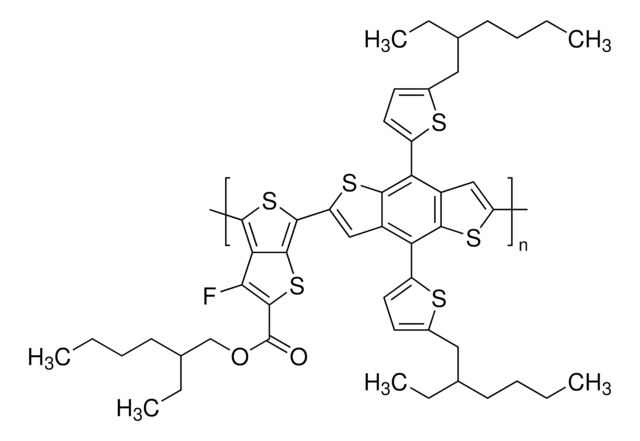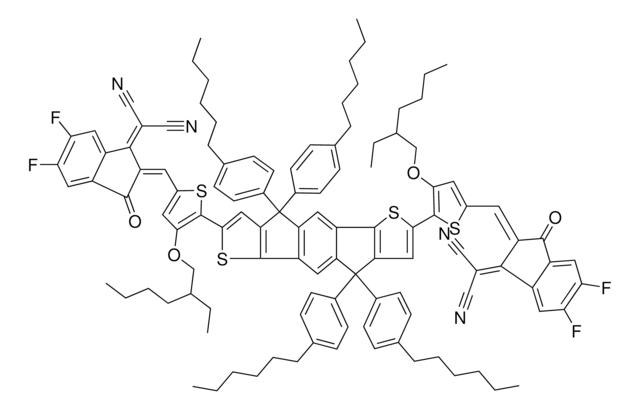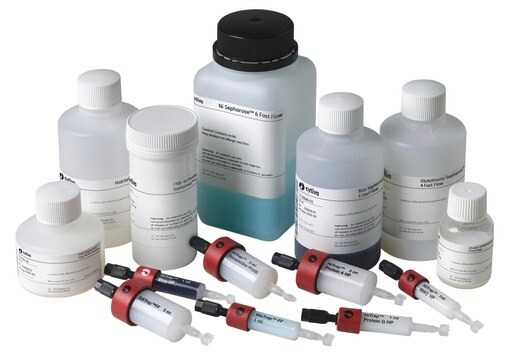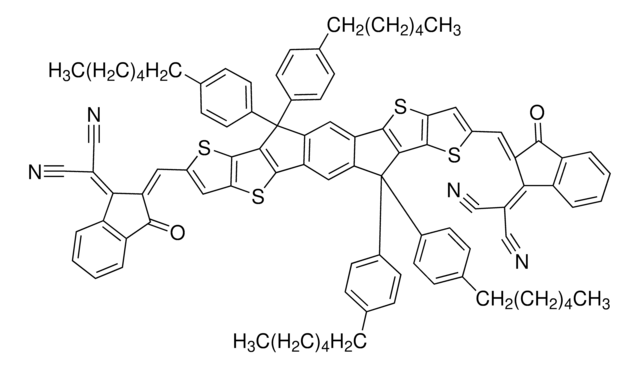Wichtige Dokumente
772372
DTS(PTTh2)2
Synonym(e):
4,4′-[4,4-Bis(2-ethylhexyl)-4H-silolo[3,2-b:4,5-b′]dithiophene-2,6-diyl]bis[7-(5′-hexyl-[2,2′-bithiophen]-5-yl)-[1,2,5]thiadiazolo[3,4-c]pyridine], 5,5′-Bis{[4-(7-hexylthiophen-2-yl)thiophen-2-yl]-[1,2,5]thiadiazolo[3,4-c]pyridine}-3,3′-di-2-ethylhexylsilylene-2,2′-bithiophene
About This Item
Empfohlene Produkte
Form
solid
mp (Schmelzpunkt)
208-213 °C
Löslichkeit
chloroform: soluble(lit.)
dichlorobenzene: soluble(lit.)
λmax
655 nm in chloroform
SMILES String
CCC(CCCC)C[Si]1(CC(CCCC)CC)C2=C(SC(C3=NC=C(C4=CC=C(C5=CC=C(CCCCCC)S5)S4)C6=NSN=C63)=C2)C7=C1C=C(C8=NC=C(C9=CC=C(C%10=CC=C(CCCCCC)S%10)S9)C%11=NSN=C%118)S7
InChI
1S/C62H72N6S8Si/c1-7-13-17-19-23-41-25-27-47(69-41)49-31-29-45(71-49)43-35-63-57(59-55(43)65-75-67-59)51-33-53-61(73-51)62-54(77(53,37-39(11-5)21-15-9-3)38-40(12-6)22-16-10-4)34-52(74-62)58-60-56(66-76-68-60)44(36-64-58)46-30-32-50(72-46)48-28-26-42(70-48)24-20-18-14-8-2/h25-36,39-40H,7-24,37-38H2,1-6H3
InChIKey
NOJURONZIGXBEP-UHFFFAOYSA-N
Allgemeine Beschreibung
Anwendung
OPV Device Structure: ITO/MoOx/DTS(PTTh2)2: PC70BM/Al
- JSC = 14.4 mA/cm2
- VOC = 0.78 V
- FF = 0.59
- PCE = 6.7%
Lagerklassenschlüssel
11 - Combustible Solids
WGK
WGK 3
Flammpunkt (°F)
Not applicable
Flammpunkt (°C)
Not applicable
Hier finden Sie alle aktuellen Versionen:
Analysenzertifikate (COA)
Die passende Version wird nicht angezeigt?
Wenn Sie eine bestimmte Version benötigen, können Sie anhand der Lot- oder Chargennummer nach einem spezifischen Zertifikat suchen.
Besitzen Sie dieses Produkt bereits?
In der Dokumentenbibliothek finden Sie die Dokumentation zu den Produkten, die Sie kürzlich erworben haben.
Artikel
Solution-processed organic photovoltaic devices (OPVs) have emerged as a promising clean energy generating technology due to their ease of fabrication, potential to enable low-cost manufacturing via printing or coating techniques, and ability to be incorporated onto light weight, flexible substrates.
Unser Team von Wissenschaftlern verfügt über Erfahrung in allen Forschungsbereichen einschließlich Life Science, Materialwissenschaften, chemischer Synthese, Chromatographie, Analytik und vielen mehr..
Setzen Sie sich mit dem technischen Dienst in Verbindung.![[6,6]-Phenyl C71 Buttersäuremethylester, Isomerengemisch 99%](/deepweb/assets/sigmaaldrich/product/structures/716/624/9fb9f2f0-ae99-429f-8d3a-b12267976a4d/640/9fb9f2f0-ae99-429f-8d3a-b12267976a4d.png)





![Poly-[(9,9-dioctylfluorenyl-2,7-diyl)-co-bithiophen] 99.9%](/deepweb/assets/sigmaaldrich/product/structures/309/000/8b4a3f54-7765-4aca-96c4-74ce328d455d/640/8b4a3f54-7765-4aca-96c4-74ce328d455d.png)


